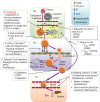Memory T-cell trafficking: new directions for busy commuters
- PMID: 20408895
- PMCID: PMC2878460
- DOI: 10.1111/j.1365-2567.2010.03278.x
Memory T-cell trafficking: new directions for busy commuters
Abstract
The immune system is unique in representing a network of interacting cells of enormous complexity and yet being based on single cells travelling around the body. The development of effective and regulated immunity relies upon co-ordinated migration of each cellular component, which is regulated by diverse signals provided by the tissue. Co-ordinated migration is particularly relevant to the recirculation of primed T cells, which, while performing continuous immune surveillance, need to promptly localize to antigenic sites, reside for a time sufficient to carry out their effector function and then efficiently leave the tissue to avoid bystander damage. Recent advances that have helped to clarify a number of key molecular mechanisms underlying the complexity and efficiency of memory T-cell trafficking, including antigen-dependent T-cell trafficking, the regulation of T-cell motility by costimulatory molecules, T-cell migration out of target tissue and fugetaxis, are reviewed in this article.
Figures

Similar articles
-
Chemokines: control of primary and memory T-cell traffic.Immunol Res. 2005;31(1):57-74. doi: 10.1385/IR:31:1:57. Immunol Res. 2005. PMID: 15591623 Review.
-
How T cells find their way around.Methods Mol Biol. 2010;616:3-13. doi: 10.1007/978-1-60761-461-6_1. Methods Mol Biol. 2010. PMID: 20379865
-
Physiologic and aberrant regulation of memory T-cell trafficking by the costimulatory molecule CD28.Blood. 2007 Apr 1;109(7):2968-77. doi: 10.1182/blood-2006-10-050724. Blood. 2007. PMID: 17119120
-
Mechanisms of T cell organotropism.Cell Mol Life Sci. 2016 Aug;73(16):3009-33. doi: 10.1007/s00018-016-2211-4. Epub 2016 Apr 1. Cell Mol Life Sci. 2016. PMID: 27038487 Free PMC article. Review.
-
Chemokine-mediated control of T cell traffic in lymphoid and peripheral tissues.Mol Immunol. 2005 May;42(7):799-809. doi: 10.1016/j.molimm.2004.06.040. Epub 2004 Nov 23. Mol Immunol. 2005. PMID: 15829268 Review.
Cited by
-
Circulating immunophenotypes are potentially prognostic in follicular cell-derived thyroid cancer.Front Immunol. 2024 Jan 3;14:1325343. doi: 10.3389/fimmu.2023.1325343. eCollection 2023. Front Immunol. 2024. PMID: 38235146 Free PMC article.
-
CTLA-4 and PD-1 Control of T-Cell Motility and Migration: Implications for Tumor Immunotherapy.Front Immunol. 2018 Nov 27;9:2737. doi: 10.3389/fimmu.2018.02737. eCollection 2018. Front Immunol. 2018. PMID: 30542345 Free PMC article. Review.
-
An integrative systems biology view of host-pathogen interactions: The regulation of immunity and homeostasis is concomitant, flexible, and smart.Front Immunol. 2023 Jan 24;13:1061290. doi: 10.3389/fimmu.2022.1061290. eCollection 2022. Front Immunol. 2023. PMID: 36761169 Free PMC article.
-
T-lymphocyte homing: an underappreciated yet critical hurdle for successful cancer immunotherapy.Lab Invest. 2017 Jun;97(6):669-697. doi: 10.1038/labinvest.2017.25. Epub 2017 Mar 27. Lab Invest. 2017. PMID: 28346400 Free PMC article. Review.
-
Activation of Th2 cells downregulates CRTh2 through an NFAT1 mediated mechanism.PLoS One. 2018 Jul 3;13(7):e0199156. doi: 10.1371/journal.pone.0199156. eCollection 2018. PLoS One. 2018. PMID: 29969451 Free PMC article.
References
-
- Gowans JL, Knight EJ. The Route of Re-Circulation of Lymphocytes in the Rat. Proc R Soc Lond B Biol Sci. 1964;159:257–82. - PubMed
-
- Marelli-Berg FM, Cannella L, Dazzi F, Mirenda V. The highway code of T cell trafficking. J Pathol. 2008;214:179–89. - PubMed
-
- Sallusto F, Lenig D, Forster R, Lipp M, Lanzavecchia A. Two subsets of memory T lymphocytes with distinct homing potentials and effector functions. Nature. 1999;401:708–12. - PubMed
-
- Lanzavecchia A, Sallusto F. Dynamics of T lymphocyte responses: intermediates, effectors, and memory cells. Science. 2000;290:92–7. - PubMed
Publication types
MeSH terms
Grants and funding
LinkOut - more resources
Full Text Sources
Other Literature Sources

